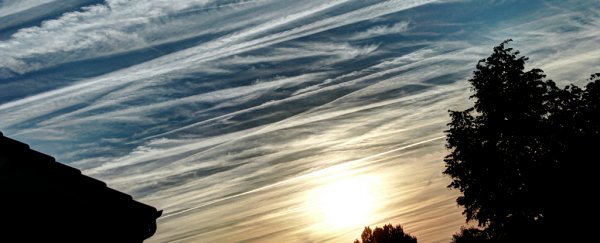The first peer-reviewed journal article has been published on the 'chemtrails' conspiracy - the idea that organisations or governments are covertly pumping chemicals into the sky via aircraft.
The researchers found no evidence of large-scale chemical spraying programs going on without our knowledge, and concluded that distinctive 'chemtrail' patterns in the sky can all be explained by the regular science of water vapour.
Despite the lack of solid evidence for chemtrails, it's a conspiracy theory that just won't die, with regular memes circulating on Facebook and Twitter (thank you, Kylie Jenner) suggesting that the clouds trailing planes are something more sinister.
— Kylie Jenner (@KylieJenner) May 26, 2015
These patterns in the sky are actually known as contrails, or condensation trails, and scientists have shown they're the result of water vapour condensing and freezing around aerosols in aircraft exhaust.
But for some reason, many people think they're caused by industries or governments pumping health-affecting or weather-controlling chemicals into the atmosphere - a 2011 international survey showed that nearly 17 percent of respondents believed in secret, large-scale spraying programs.
"We wanted to establish a scientific record on the topic of secret atmospheric spraying programs for the benefit of those in the public who haven't made up their minds," said lead researcher Steven Davis from the University of California, Irvine.
"The experts we surveyed resoundingly rejected contrail photographs and test results as evidence of a large-scale atmospheric conspiracy."
To find out what was going on, the team interviewed 77 scientists who should know what they're talking about - they were either atmospheric chemists who specialise in condensation trails, or geochemists working on atmospheric deposition of dust and pollution.
Out of the group, 76 of the 77 experts said they hadn't come across evidence of secret, large-scale spraying programs.
The evidence that the 77th had come across was "high levels of atmospheric barium in a remote area with standard 'low' soil barium".
In other words, she's seen an imbalance that could be explained by chemicals being sprayed into the atmosphere, but hadn't come across any signs of nefarious activity.
On top of that, the researchers were shown four images commonly circulated as chemtrails, and 100 percent of them said they were just ordinary contrails - and they provided peer-reviewed citations to back up their claims.
The researchers also suggested that contrails are more common these days simply because air travel is becoming more regular.
"Despite the persistence of erroneous theories about atmospheric chemical spraying programs, until now there were no peer-reviewed academic studies showing that what some people think are 'chemtrails' are just ordinary contrails, which are becoming more abundant as air travel expands," said one of the researchers, Ken Caldeira from the Carnegie Institution for Science.
"Also, it is possible that climate change is causing contrails to persist for longer periods than they used to."
The team admits that their research probably won't sway the opinion of anyone who already believes in chemtrails, but they hope that by providing a peer-reviewed study on the subject, people new to the topic will find something objective when doing their research.
"I felt it was important to definitively show what real experts in contrails and aerosols think," said Caldeira. "We might not convince die-hard believers that their beloved secret spraying program is just a paranoid fantasy, but hopefully their friends will accept the facts."
The research has been published in Environmental Research Letters.
